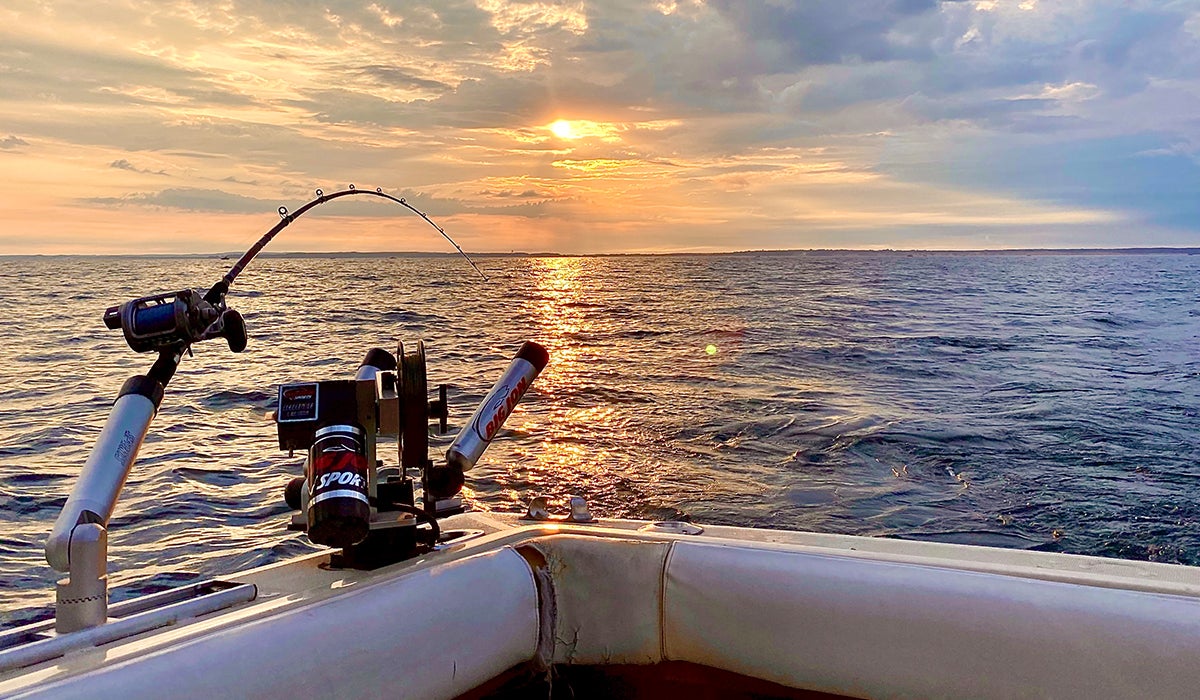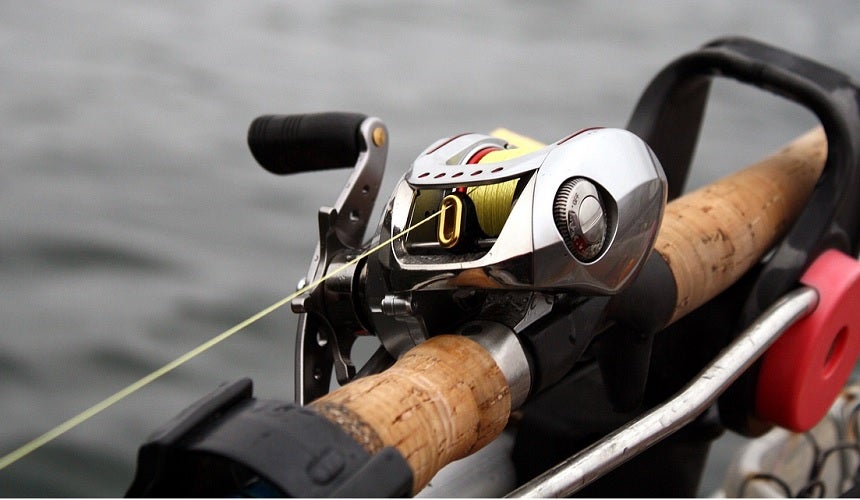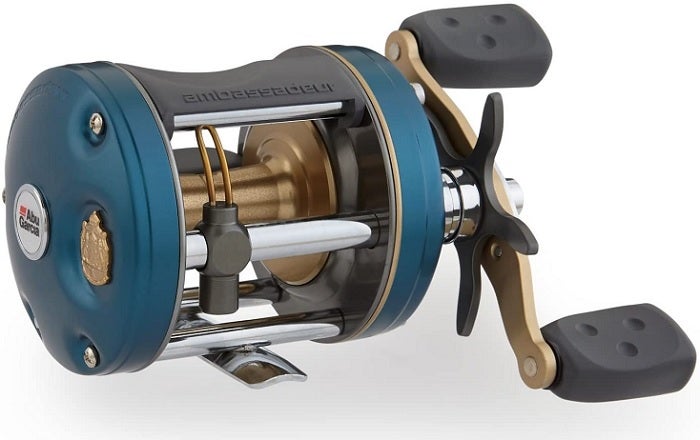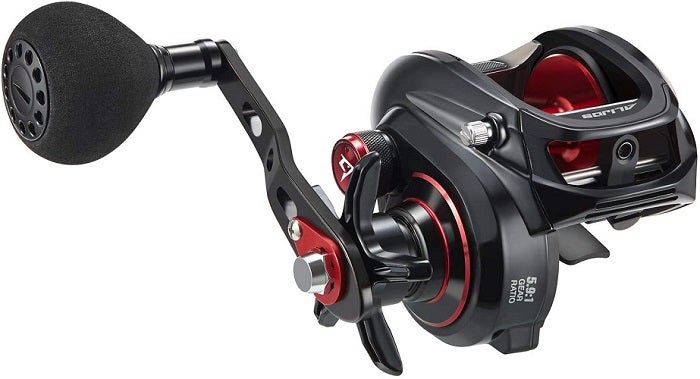
Our Editors independently research, test, and rate what we feel are the best products. We use affiliate links and may receive a small commission on purchases.
Saltwater angling requires specialized equipment. Seems obvious enough, right? When it comes to baitcasting reels, there are multiple reasons why you need to pay special attention to what you purchase if you plan to have success in your fishing adventures. It all comes down to two very important features that you need in a saltwater baitcasting reel – Corrosion resistance and gearing. The chemical male up of saltwater is really hard on anything mechanical, so your reel, and even the rod, has to be up to the task. The last thing you want is for your reel to give out halfway through the fight when you’re trying to crank in the leviathan of a lifetime. Don’t worry, my friends. I’m here to help. If you’re ready to live the Salt Life, it’s time to gear up and go.
Cover image by Derrek Sigler
Best Saltwater Baitcast Reels
| Shimano Torium Star Reel | Abu Garcia C4-6601 Ambassadeur Reel | Piscifun Alijos Baitcasting Reels | |
|---|---|---|---|
| Bearings: | 3+1 | 4+1 | 8+1 |
| Drag: | 24 lbs | 15 lbs | 33 lbs |
| Gear Ratio: | 6.2:1 | 6.3:1 | 5.9 or 8.1:1 |
| Weight: | 18.9 oz | 9.3 oz | 11.3 oz |
For more of my fishing gear recommendations, have a look through these popular Outside Pursuits guide links: Baitcasting Rods, Tackle Boxes, Fishing Sunglasses.
Quick Answer: The Best Rated Saltwater Baitcasters For 2021
- Shimano Torium Star Drag Reel
- Abu Garcia C4-6601 Ambassadeur Baitcast Reel
- Piscifun Alijos Size 300 Baitcasting Reels
- Daiwa Coastal TW Casting Reel
- Piscifun Salis X Inshore Saltwater Baitcasting Reel
- Lews Fishing SSN1SH Baitcasting Reel
- Abu Garcia Revo X Inshore Low Profile Casting Reel
Our reviews of the top rated saltwater casting reels with our guide and comparison table will help you choose the right reel for you.
Saltwater Baitcasting Reel Reviews
#1 Shimano Torium Star Drag Reel
- Bearings: 3+1
- Drag: 24lbs
- Gear Ratio: 6.2:1
- Weight:18.9 oz
Shimano is one of the most-trusted names in fishing. If you want a refined, classic-style reel that will be a reliable workhorse for years this is a great place to start.
Right out of the gate you’ll notice the huge positive grip and large cranking arm. This is designed specifically to give you tons of power to reef on those big fish and bring them to the boat.
Alongside that, the spool is huge too. It’s sized to handle 530 yards of 50 pound braid which is just a ton of line.
While the bearing count may not be impressive at 3+1 I think Shimano’s rep and this reel’s well-loved legacy speak for themselves. It also brings in anti-corrosion coatings on the gears and internals for a long life.
Best for a simple and proven workhorse when it’s time to troll or jig for big ones.
#2 Abu Garcia C4-6601 Ambassadeur Baitcast Reel
- Bearings: 4+1
- Drag: 15 lbs
- Gear Ratio: 6.3:1
- Weight: 9.3 oz
Abu is a well-loved brand that has no lack of experience designing winning reels. This full-size saltwater baitcasting reel is ready to tackle anything from trout to sea bass.
With a 6-pin centrifugal brake system this reel is simple and reliable. In fact if I had to pick just one brake system for a reel it would be a quality centrifugal brake, so that’s perfect.
This reel is available in 3 different major sizes. Of these, the largest is capable of holding 310 yards of 50lbs braid which should be enough for practically any situation.
At 15 pounds of max drag I think the brakes leave something to be desired for larger species, but 15 pounds is nothing to sneeze at either.
Overall, it’s a good-looking reel with all the features you’d expect from a full-size saltwater rig at a reasonable price.
Best for those trolling for moderate fish on a budget.
#3 Piscifun Alijos Size 300 Baitcasting Reels
- Bearings: 8+1
- Drag: 33 lbs
- Gear Ratio: 5.9 or 8.1:1
- Weight: 11.3 oz
Piscifun was a brand I had assumed to be “cheap” until I used their reels. While they’re not bleeding edge, I still feel this brand provides amazing value for the money and deserves a look.
With more bearings and more drag than substantially more expensive reels from competitive name brands, it’s easy to see why Piscifun delivers value.
33 pounds of drag is up there with the beefiest saltwater baitcasting reels. On top of that the oversized brass gears are designed to take a beating and stand up to it.
Outside the reel is a huge crank arm and an oversized handle that provides tons of grip to fight those fish that bust out on a long run.
Best for those on a budget looking for the absolute maximum value for the money.
#4 Daiwa Coastal TW Casting Reel
- Bearings: 7+1
- Drag: 25 lbs
- Gear Ratio: 7.1:1
- Weight: 9 oz
Daiwa’s top end reels are nothing short of precision and expertise. We’ve included the Coastal on our list because it’s got the quality and brawn to put the stop on big fish.
One standout feature of the Coastal model is the huge Winn grips. These grips stand out because of their color, size, and tacky texture. This means more positive grip and control when fighting fish even if the handle is wet.
On top of that, the handle is set on a 120mm cranking arm which provides tons of leverage to reel fish in. On a 7.1:1 ratio reel this means a balance of retrieve speed and torque.
This is a low-profile style casting reel that’s perfect for precision casting to targets in shallow to moderate water.
Best for casting with a low-profile moderately priced baitcaster.
#5 Piscifun Salis X Inshore Saltwater Baitcasting Reel
- Bearings: 6+1
- Drag: 37 lbs
- Gear Ratio: 6.2:1
- Weight: 35.6 oz
Piscifun comes in with another beefy, affordable, workhorse of a trolling reel here. This one is for brutes – big fish, big rods, and big lures.
While it may weigh as much as a brick, that’s because it’s designed to take a beating. If you order the 5000 series you’ll be able to load 520 yards of 80lbs braided line.
That’s an absolute crazy amount of heavy line and you’ll need all that and more to handle the 37 pound drag system.
It’s preloaded with ears to clip on a strap if you plan to battle the biggest and baddest saltwater monsters. Plus, the oversized crank and handle are both beefed up to give you loads of leverage for the fight.
Best for targeting big fish on a trolling rig.
#6 Lews Fishing SSN1SH Speed Spool Baitcasting Reel
- Bearings: 6+1
- Drag: 20 lbs
- Gear Ratio: 7.5:1
- Weight: 7.3 oz
Lew’s is a great fishing brand well-loved by recreational anglers and pros both. Their reputation for great gear extends to this low-profile baitcaster.
At a fraction of the size and weight of the larger baitcasters on our list, this low-profile inshore reel is a casting machine. It’s got a 7.5:1 gear ratio for fast retrieves which means more casts, and faster casts.
It has an external controlled magnetic brake system which is used to control spool overrun. Paired with the spool tension knob this provides all the braking adjustment for your casts.
Holding 140 yards of 12lbs test line it’s not going to take huge runs from massive fish. This is an in-shore reel for casting around cover and hunting for those moderate sportfish. That said, the 20 pounds of drag will put the brakes on any but the absolute biggest fish.
Best for inshore casting on moderate to smaller species.
#7 Abu Garcia Revo X Inshore Casting Reel
- Bearings: 6+1
- Drag: 30 lbs
- Gear Ratio: 6.6:1
- Weight: 12.2 oz
Abu’s Revo series has long been the standard of affordable performance among recreational anglers. Can it hold up against competitors like the Speed Spool and the Lexa? I think so.
A note upfront: when I went to Abu’s website it failed to list the weight of the reel and the max drag. Seemingly large oversights on such a reputable manufacturer.
Abu knows how to build reels that work, though, and their inshore reel is sure to handle anything you throw at it. I like that it has a built-in lubrication port, too. This is an often overlooked feature on many high-end reels.
I also like the lower 6.6 gear ratio which means slower retrieve but greater leverage for bigger fish. If you’re planning to target large fish and push the limits of your reel, the lower gear ratio will help.
Best for a low gear ratio inshore casting reel for winning tough fights.
Saltwater Casting Reel Comparison Table
| Saltwater Baitcast Reels Comparison | Bearings | Drag | Gear Ratio | Weight | Rating | |
|---|---|---|---|---|---|---|
| Shimano Torium Star Reel | 3+1 | 24 lbs | 6.2:1 | 18.9 oz | 4.5 / 5.0 | |
| Abu Garcia C4-6601 Ambassadeur Reel | 4+1 | 15 lbs | 6.3:1 | 9.3 oz | 4.3 / 5.0 | |
| Piscifun Alijos Baitcasting Reels | 8+1 | 33 lbs | 5.9 or 8.1:1 | 11.3 oz | 4.7 / 5.0 | |
| Daiwa Coastal TW Casting Reel | 7+1 | 15 lbs | 7.1:1 | 9 oz | 4.6 / 5.0 | |
| Piscifun Salis X Saltwater Baitcasting Reel | 6+1 | 37 lbs | 6.2:1 | 35.6 oz | 4.7 / 5.0 | |
| Lews Fishing SSN1SH Baitcasting Reel | 6+1 | 20 lbs | 7.5:1 | 7.3 oz | 4.0 / 5.0 | |
| Abu Garcia Revo X Casting Reel | 6+1 | 30 lbs | 6.6:1 | 12.2 oz | 4.5 / 5.0 |
How to Choose the Best Saltwater Baitcasting Reel for You

Types of Baitcasting Reels
Baitcasters come in two primary varieties. You can go with the popular in-shore and bass-style reels called “low profile”. Alternatively, you can also opt for the traditional huge-spooling saltwater baitcasters.
These two varieties differ primarily in their castability, line capacity, and braking power.
Traditional large-spool baitcasting reels are much bulkier and less agile than their low-profile counterparts. They make up for those drawbacks, however, with substantial drag power and spool size. Because they’re larger they have room for bigger gears, larger drag discs, and longer spools of heavy braided line.
Try to spend a day on the water casting a large-spool baitcaster into tight cover or doing accurate roll casts, though, and you’ll soon find out why low-profile baitcasters win in this arena. Low-profile baitcasting reels lack the huge spools and heavy drag but are lightweight, accurate, and easy to cast with precision.
Drag Maximum
Drag power refers to the maximum amount of stopping power a reel can produce. Drag is created by discs inside the reel which rub together to form a specific amount of adjustable friction.
Saltwater fish tend to be large and capable of pulling drag on lightweight reels. Most freshwater reels max out around 12 pounds of drag or so. Many saltwater anglers, on the other hand, prefer multiple times that amount of drag.
If you’re fishing in-shore you can probably get away with a reel built for 20 pounds of drag. For larger species, you may need even more! Some anglers like drag settings approaching 30 pounds.
Remember that most lines are rated for half or less of your drag. If you’re fishing 10-pound line, most manufacturers recommend a 2-4 pound drag setting. For 30 pounds of drag, you’ll need to be fishing a 60-80 pound braided line on your reel.
Gear Ratio
Fishing reels always have a specified gear ratio. What this defines is the relationship between turning the handle and turning the spool.
For instance, if you have a reel with a gear ratio of 5:1 then every 1 turn of the handle causes the spool to complete 5 full revolutions.
Gear ratio has two direct tradeoffs:
High gear ratios reel in your lure more quickly.
Low gear ratios produce more torque.
A high gear ratio reel is great for easily covering distance and pulling line in quickly. It helps you catch up to the fish quicker and reel in faster after every cast. Unfortunately, high gear ratios are also much harder to put the pull on big, hard-fighting fish.
Low gear ratio reels are workhorses. Like putting your truck in low gear to pull a stump, a low gear-ratio reel has more power for pulling in big fish.
Line Retrieve
Gear ratio is only one part of the story. While a 5:1 gear ratio will always cause 5 revolutions of the spool for every one turn of the handle, the story goes on.
Because each reel has a different size spool, the amount of line that is taken up per turn of the spool can change dramatically from one to the next.
One reel might take up 23” of line per revolution while another could take up 31”.
Finding a line speed and gear ratio that matches what you want to do is critical. If you are using swimbaits for in-shore trout you might want a fast retrieve and high gear ratio. If you’re bottom dragging on the flats you might want something slower and more powerful.
Don’t expect one reel to do every job perfectly. A reel with fast line take-up isn’t the solution to every problem. Sometimes you need less line, a slower retrieve, and more power.
Line Capacity
Each saltwater baitcasting reel will have a different maximum line capacity. These ratings define how much of any type of line you can fit onto your spool. If you want to cast further or fight fish that take really long runs, you’ll want greater line capacity.
Check the product spec for the reel you’re looking at to find line the capacity listing. Usually, it will be listed as “30lbs braid 300 yards” and is simple to understand.
While line capacity is straightforward there are a few things to keep in mind.
If you’re planning to use a line size that’s not listed you’ll have to guess. For instance, if a reel is rated for 200 yards of 20lbs braid and 400 yards of 10lbs braid, you can guess that it will hold about 300 yards of 15lbs braid.
Because different types of lines are inherently different sizes, be sure to check for the type of line you plan to use. Braid, monofilament, and fluorocarbon all have different ratings.
Construction and Materials
Baitcasting reels can be made from, essentially, three different materials: graphite/carbon, aluminum, and plastics.
Extremely cheap baitcasters may use plastics in their frame or components. Skip them. Even if those plastic components don’t break (and they will) they’ll definitely flex which causes poor performance.
Many modern reels use some types of carbon or graphite. These materials are often used in carbon drag systems. They can also be used in frames, cranking armatures, and other areas of the reel. Graphite reel components are very lightweight but not quite as sturdy as aluminum.
Aluminum, while still light compared to many metals, is still the heaviest of these materials. That said, it makes up for it by being extremely strong and rigid. This means little to no flexing when setting hooks, fighting, or cranking on even the biggest brutes. Overall aluminum is probably the best performing choice for saltwater reel bodies.
Other materials may include brass and stainless steel. These materials are both popular for internal gears, frame components, and other items. They’re both highly corrosion resistant and, when used right, make good additions to a well-rounded saltwater baitcasting reel.
Keep in mind when buying a saltwater baitcasting reel that you need it to be corrosion resistant. Many freshwater baitcasters aren’t designed to hold up against the corrosive force of salt.
Bearings
Bearings are used to support, stabilize, and reduce friction on the moving parts of a reel. Usually the spool and crank arms have bearings in them.
Bearings come in several different types but stainless steel ball bearings are common on most reels.
While it stands to reason that more bearings equals better performance, that’s not always the case. I have found that performance in baitcasting reels is more about the overall quality and build of the reel than the number of bearings.
In an apples-to-apples comparison I would probably choose the reel with the better or greater number of bearings to settle a stalemate.
How to Cast a Baitcasting Reel
FAQs About Saltwater Casting Reels
Q: Are baitcasters good for saltwater fishing?
A: Yes, baitcasters are great for saltwater fishing.
That said, you need to make sure that you get one rated for saltwater. Saltwater is very corrosive and can quickly destroy freshwater baitcasters if they’re not made to hold up against it.
Saltwater baitcasters are typically also designed with larger spools than their freshwater cousins. Saltwater fish tend to be larger, fight harder, and take longer runs and therefore a saltwater baitcaster needs to be able to hold more/larger line.
Q: Why are baitcasters better than spinning reels?
A: Baitcasters have some advantages over spinning reels.
Because of the design of a baitcaster, the spool, line, and handle are placed in such a way that power transfers efficiently when setting the hook and cranking.
Another advantage is that baitcasters leave the spool open and accessible to the thumb. That means you can “thumb the spool” to very accurately control how far and where your cast will go. It’s much easier to place an accurate cast with a baitcasting reel.
Keep in mind, however, that spinning reels have a few advantages of their own.
Compared to large saltwater baitcast reels, spinning reels sit more comfortably in the grip. They’re less tiring to cast and hold.
Also, spinning reels are largely free from the hellish phenomenon called “backlash”. While baitcasters, when used wrong, can create a birds nest of line and ruin your day, spinning reels will not. They’re much easier for beginners to learn and master.
Q: Is braided line good for baitcasters?
A: Braided line is great for baitcasters! It casts smooth and far and it won’t kink up on you like monofilament or fluorocarbon line can.
Braid also has much less line memory. It’s less prone to coming off the spool in coils after being stored for a while. Mono and flouro, on the other hand, can have nasty line memory problems.
Braided line has very little or no stretch. That means you can feel a strike or a bump off structure with braid instantly. Additionally, it’s substantially more abrasion and cut resistant than mono or flouro. That makes it a great choice around structure and for use with big, toothy fish.
At the end of the day, braid is a total pleasure to cast on a good baitcaster.
Q: What do magnetic brakes do on a baitcaster?
A: Baitcasting reels may have magnetic or centrifugal brakes. Often both.
Magnetic brakes are used to control low-speed spool performance. Magnetic brakes use electromagnetic forces generated by the spinning spool to control how fast the line leaves the spool.
Magnetic brakes are great because they can be adjusted without taking the cover off of a baitcasting reel.
While they’re awesome, magnetic brakes sometimes can’t keep up with the initial force of a cast. Centrifugal brakes provide a lot more stopping power at high spool-speeds than magnetic brakes can.
I’ve used baitcasters with magnetic brakes, centrifugal brakes, and both brakes. To find out which type you like best you’ll have to do a little trial and error.
Q: Can I use a low-profile baitcaster for saltwater?
A: Yes.
Low-profile saltwater reels do exist but they’re mainly for in-shore fishing.
These reels are lighter than full-size saltwater baitcast reels. You can find some, such as the Shimano TranX with drags in the mid 20-pound range. They lack the line capacity of large baitcasting reels, however.
Basically if you’re going shallow for moderate fish, a low-profile reel will work fine. If you’re looking for the big kahunas, or trolling for fish that fight a full-size saltwater reel will work great.
Final Thoughts
Whether you’re rigging up for trolling or casting along the pilings at the pier, we’ve got something on our list for you. These reels are made to handle the corrosive saltwater environment inshore and saltwater anglers throw at them.
There’s not one right reel for everyone. We each have to decide which reel is right for our needs. Once you’ve been fishing a while you’ll find that multiple reels are great for varying situations so you can never have too many!
How We Researched
To come up with the top saltwater baitcasting reel we researched a variety of sources for reviews such as REI, Dicks Sporting Goods and Bass Pro Shops along with our own personal experience.
We also consulted online magazines for product research and reviews to get as much unbiased information as we could. To help weed out fake reviews we used Fakespot.com to make sure we only looked at genuine reviews.
With so much quality gear available, we had to narrow it down based on what we felt were the best options for the price. The author, Casey Fiedler has been an avid fisherman for decades and leads fishing trips into the backcountry.
To help narrow down the selection our authors used their personal experience along with recommendations from charter captains and tour guides.
After extensive research, we came up with our list to help you choose the right one for you.
Sources


